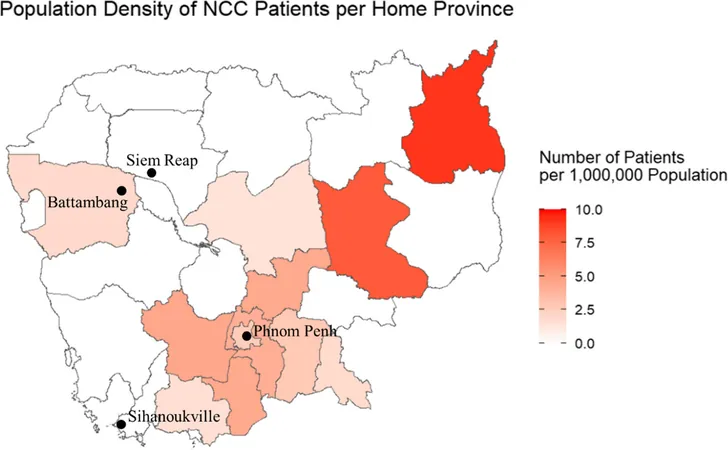
Breakthrough Study Reveals HPV Infection Trends in Cervical Cancer Patients in Cambodia
2025-08-29
Author: Arjun
Cervical Cancer Crisis in Cambodia
Cervical cancer has become a pressing health issue in Cambodia, ranking as the second-most common cancer among women. Annually, the country faces about 1,274 new cases and approximately 670 fatalities. In a bid to combat this, the Cambodian government has recently integrated HPV vaccination for 9-year-old girls into its national immunization schedule as of October 5, 2023. To maximize this vaccination campaign's potential, a deep understanding of HPV's prevalence and impact in Cambodia is crucial.
Insightful Study Using Advanced Techniques
To shed light on the situation, researchers conducted a groundbreaking study at Calmette Hospital in Phnom Penh, analyzing 50 samples of cervical cancer tissue obtained from archived biopsies. The specimens, collected between April 2019 and March 2020, underwent next-generation sequencing to identify various HPV types. Additionally, samples from 47 non-cancerous cervical tissues collected from another facility between January 2020 and March 2021 were analyzed as well. The findings were alarming yet enlightening.
Shocking HPV Prevalence Rates Uncovered
The results revealed that a staggering 83.3% of cervical cancer patients harbored HPV types 16 and 18, known to be responsible for about 70% of cervical cancer cases globally. HPV type 58 was identified in 11.9% of the cancer specimens. Notably, very few cancer samples (only 2.4%) contained multiple HPV subtypes. Interestingly, no HPV DNA was detected in any of the control samples, suggesting a stark contrast between cancer and non-cancer patients.
Call for Action: Strengthening Vaccination Efforts
This pioneering study serves as a critical data source for refining Cambodia's vaccination strategy. With the prevalence of HPV-16 and HPV-18 closely mirroring global rates, the findings indicate that the current vaccination efforts won't be hampered by an unusually high presence of other non-vaccine strains. However, the surprisingly high rate of HPV-58 calls for a closer look at the potential benefit of the nonavalent vaccine, which covers additional strains directly.
Geographic Insights and Future Research Directions
The study also underscored geographic disparities in HPV types across different provinces, hinting at potential socio-economic factors influencing HPV prevalence. As Cambodia launches its first comprehensive HPV vaccination campaign, these insights will be key in tailoring effective public health interventions.
In Conclusion: A Path Forward for Cambodia’s Health Strategy
This inaugural study on HPV prevalence among cervical cancer patients in Cambodia highlights an urgent need to continue research and refine vaccination policies. As Cambodia steps up its fight against cervical cancer, understanding the diverse landscape of HPV strains will be vital to saving lives and preventing future infections.



 Brasil (PT)
Brasil (PT)
 Canada (EN)
Canada (EN)
 Chile (ES)
Chile (ES)
 Česko (CS)
Česko (CS)
 대한민국 (KO)
대한민국 (KO)
 España (ES)
España (ES)
 France (FR)
France (FR)
 Hong Kong (EN)
Hong Kong (EN)
 Italia (IT)
Italia (IT)
 日本 (JA)
日本 (JA)
 Magyarország (HU)
Magyarország (HU)
 Norge (NO)
Norge (NO)
 Polska (PL)
Polska (PL)
 Schweiz (DE)
Schweiz (DE)
 Singapore (EN)
Singapore (EN)
 Sverige (SV)
Sverige (SV)
 Suomi (FI)
Suomi (FI)
 Türkiye (TR)
Türkiye (TR)
 الإمارات العربية المتحدة (AR)
الإمارات العربية المتحدة (AR)